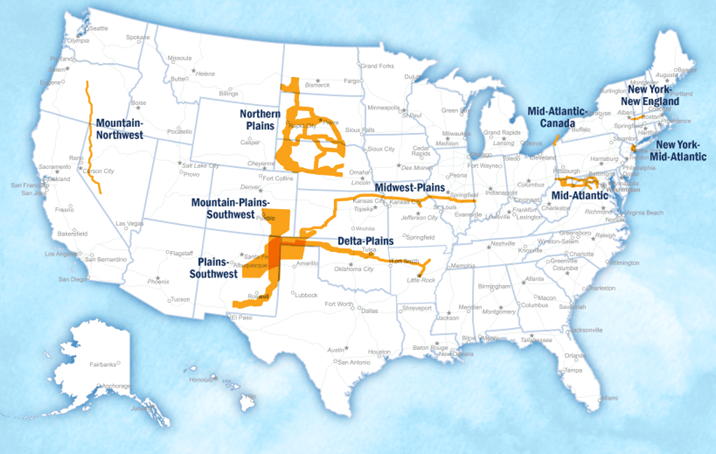On May 13, 2024, the Federal Energy Regulatory Commission (“FERC” or Commission) issued a final rule amending its regulations governing FERC’s review of applications for transmission siting permits pursuant to section 216 of the Federal Power Act (“FPA”), commonly referred to as FERC’s backstop transmission siting authority (the “Transmission Siting Rule”). Order No. 1977 is intended to reinvigorate FERC’s limited transmission siting authority for interstate electric transmission projects and provides a path for FERC to use its jurisdiction under FPA section 216 to grant siting permits to developers of transmission projects located in certain designated geographic regions of the country (National Interest Electric Transmission Corridors, or “NIETCs”), even when the developer has been unable to secure siting permits from the applicable state or local authority. Permits issued under section 216 confer eminent domain authority onto the project developer.
FERC approved the Transmission Siting Rule by a unanimous vote, in contrast with FERC’s approval of Order No. 1920 (related to regional transmission planning on cost allocation), approved on the same day by a 2-1 vote over the dissent of Commissioner Mark Christie. One major change between the Transmission Siting Rule and its underlying Notice of Proposed Rulemaking (“NOPR”) is that the Commission declined to allow applicants to simultaneously file state and federal transmission siting applications to help expedite the federal permitting process. Instead, applicants will need to proceed through the appropriate state process first and then, only after a denial of their state process or a delay of over a year, will applicants be allowed to file applications with FERC. It is possible that this change between the NOPR and the Transmission Siting Rule helps to explain, at least in part, the absence of any dissent.
Background
The Transmission Siting Rule is part of a broader set of actions by the federal government to promote transmission development and transmission investment in the United States, which has included a flurry of both legislative and administrative activity. The Transmission Siting Rule itself carries forward Congress’s intent in the 2021 Infrastructure Investment and Jobs Act (“IIJA”) to revive FERC’s backstop transmission siting authority. Further, the Transmission Siting Rule relates directly to the US Department of Energy’s (“DOE”) recent publication of preliminary NIETCs for public comment. These are the first NIETCs designations issued since 2007 (earlier DOE NIETC designations were later vacated by a federal court of appeals).
FPA Section 216
Congress established section 216 in the Energy Policy Act of 2005 (“EPAct 2005”), but subsequent federal court opinions sharply limited its applicability, including the 2009 Piedmont decision, in which the US Court of Appeals for the Fourth Circuit found that FERC did not have backstop siting authority where a state affirmatively denied the project’s permit application.[1] The IIJA explicitly “undoes” the statutory interpretation on which the Piedmont court relied and empowers FERC to exercise federal jurisdiction over the siting of certain power transmission projects even when such siting authority has been expressly rejected by a state agency.
Role of the DOE
The basic framework of section 216 begins with the DOE, which is required to complete studies every three years to identify geographic regions of the country where there is an acute need for the development of additional transmission facilities, known as NIETCs. On May 8, 2024, the DOE announced a preliminary list of 10 NIETCs located throughout the country. Before finalizing the NIETCs, DOE must conduct a National Environmental Policy Act (“NEPA”) analysis of the environmental impacts of DOE’s NIETC designations. This analysis is separate and distinct from the FERC-led project-specific NEPA process as established by the Transmission Siting Rule. Once finalized, FERC may exercise siting jurisdiction over proposed interstate transmission projects located within the NIETCs, provided that the project applicant meets certain requirements and that their state-level siting application has been denied or has been pending for more than one year.
Map of DOE’s Preliminary NIETC Designations, as of May 8, 2024

After the enactment of EPAct 2005, FERC promulgated regulations to implement section 216, which largely have lain dormant. In the Transmission Siting Rule, FERC proposes to keep many of those regulations in place. The Transmission Siting Rule amends its regulations by (1) making explicit that a state’s denial of a transmission siting application can form the basis of FERC jurisdiction over a proposed transmission project and (2) requiring the submission of additional landowner engagement information to FERC, including submission of evidence of engagement with environmental justice communities.
Summary of Changes to Existing FERC Regulations Implementing Section 216
Pursuant to the directive of the IIJA, FERC amends its regulations to reflect its jurisdiction over projects located in a NIETC that have been denied state siting authority.
Departing from its NOPR proposal, FERC declines to amend its regulations to allow for the simultaneous processing of federal and state siting applications. Instead, FERC’s current policy requiring applicants to wait one year after the filing of a state siting application before applying to FERC will remain in effect.[2] In short, applicants seeking to take advantage of FERC’s section 216 regulations will need to first proceed exclusively at the state level and if, after one year, they have been unable to secure siting authority from the appropriate state authority, they may then proceed with filing an application at FERC.
In terms of application procedures, at a high level, the Transmission Siting Rule establishes a federal power transmission siting process that reflects some of the same rules and application requirements that FERC applies to interstate natural gas certificate projects under section 7 of the Natural Gas Act. For example, FERC directs transmission siting applicants to include in their applications:
- Evidence of stakeholder engagement, in the form of a Project Participation Plan.
- An Environmental Justice Public Engagement Plan, which must describe the applicant’s engagement with “environmental justice communities.”
- Notice of the project to affected landowners within a specified time period after submission of an application to FERC.
- Fourteen resource reports, which is largely consistent with FERC’s NEPA regulations but also adds three new resource reports related to tribal resources (Resource Report 6), environmental justice (Resource Report 7), and air quality and environmental noise (Resource Report 11). At a high level, the sum total of these resource reports will require information related to, inter alia:
- Estimated emissions from the proposed project, as well as associated impact on air quality and on the surrounding noise environment (Resource Report 11);
- Impacts on the visual characteristics of the surrounding lands and waters affected by the project (Resource Report 10); and
- Alternatives to the proposed project, including alternatives other than new transmission lines (Resource Report 12).
Further, consistent with a recently promulgated rule in the natural gas certificate context (Order No. 871 and its progeny), the Transmission Siting Rule limits the ability of applicants to proceed with construction of an approved project if a request for rehearing of the authorization order is pending before the Commission. However, as with Order No. 871, a qualifying request for rehearing must reflect opposition to project construction, operation or need, so not all requests for rehearing will prevent the applicant from proceeding with construction.
As a practical matter, it is difficult to anticipate how state regulators would view a transmission developer that proceeds with a project after receiving a FERC ruling following state denial of siting request (i.e., how would state officials treat such a developer on an ongoing basis once the facility was operational). This could be a particular concern for transmission and distribution utilities that are subject to extensive state regulation.
[1] Piedmont Env’t Council v. FERC, 558 F.3d 304 (4th Cir. 2009) (holding that FERC did not have jurisdiction over transmission siting in the event of a denial by a state agency and vacating FERC’s NEPA regulations for section 216 applications for failing to consult with the Council on Environmental Quality in promulgating them); Cal. Wilderness Coal. v. U.S. Dep’t of Energy, 631 F.3d 1072 (9th Cir. 2011) (vacating certain DOE National Corridor designations).
[2] This policy was initially announced in FERC’s Order No. 689. Regulations for Filing Applications for Permits to Site Interstate Electric Transmission Facilities, Order No. 689, 117 FERC ¶ 61,202,at P 21 (2006).








 />i
/>i
